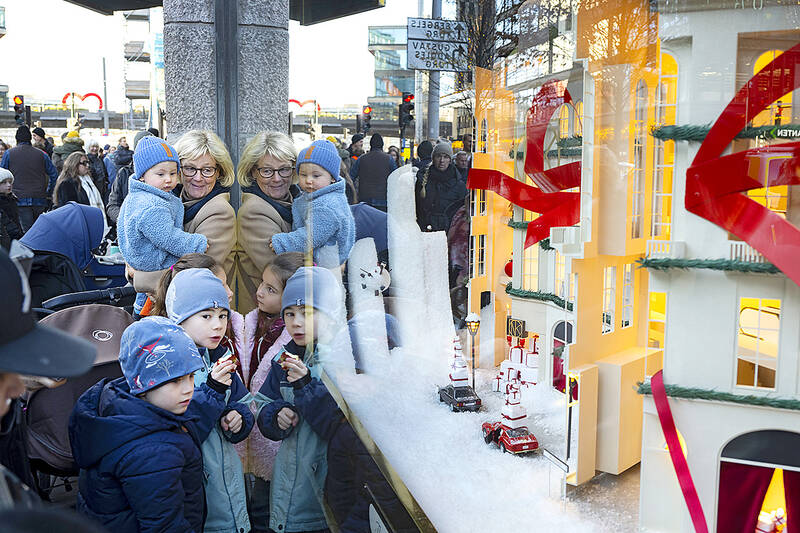“Bro, I can’t wait for my first dead body,” wrote an 11-year-old boy on Instagram in Sweden, where gangs recruit children too young to be prosecuted as contract killers on chat apps.
“Stay motivated, it’ll come,” answered his 19-year-old contact. He went on to offer the child 150,000 kronor (US$13,680) to carry out a murder, as well as clothes and transport to the scene of the crime, according to a police investigation of the exchange last year in the western province of Varmland.
In this case, four men aged 18 to 20 are accused of recruiting four minors aged 11 to 17 to work for a criminal gang. All were arrested before carrying out the crimes.

Photo: EPA-EFE
The preliminary inquiry contains a slew of screenshots that the youngsters sent to each other of themselves posing with weapons, some with bare chests or donning hooded masks.
Questioned by police, the 11-year-old said he wrote the message to seem “cool” and “not show his fear.”
The case is not an isolated one.
Sweden has struggled to rein in a surge in gang shootings and bombings across the country in recent years, linked to score-settling and battles to control the drug market.
Last year, 53 people were killed in shootings, increasingly in public with innocent victims also dying.
‘KILLER WANTED’
Sweden’s gang crime is organized and complex with gang leaders operating from abroad through intermediaries who use encrypted messaging sites like Telegram, Snapchat and Signal to recruit teens under 15, the age of criminal responsibility.
“It is organized as a kind of (job) market where missions are published on discussion forums, and the people accepting the assignments are increasingly young,” Johan Olsson, the head of the Swedish police’s National Operations Department (NOA), told reporters last month.
Hits are subcontracted with the parties only communicating online, Stockholm University criminology professor Sven Granath said.
Others recruit in person, seeking out kids hanging around in their neighborhoods.
The number of murder-related cases in Sweden where a suspect is under the age of 15 rose from 31 in the first eight months of last year to 102 in the same period this year, according to the Prosecution Authority.
Granath said the children who are recruited are often struggling in school, have addiction problems or attention deficit disorders, or have already been in trouble with the law.
“They are recruited into conflicts they have no connection to — they’re just mercenaries,” he said, adding that they haven’t necessarily been a member of a gang before. Some children even seek out the contracts, according to a report from the National Council for Crime Prevention (BRA), as they look for cash, an adrenaline rush, recognition or a sense of belonging.
They’re drawn in by flashy clothes as well as the promise of undying loyalty, experts say.
“Nowadays everybody wants to be a murderer,” said Viktor Grewe, a 25-year-old former gang member who had his first run-in with police when he was 13.
“It’s incredibly sad to see that this is what kids aspire to,” he said, with some “crimfluencers” glorify criminal lifestyles on TikTok.
‘RUTHLESS EXPLOITATION
There is a “ruthless exploitation of young people,” said Tony Quiroga, a police commander in Orebro, west of Stockholm.
The criminal subcontractors “don’t want to take any risks themselves,” he said, protecting both themselves and those higher up the chain.
“They hide behind pseudonyms on social media and put several filters between themselves and the culprit.”
In Orebro, volunteers patrol the streets of disadvantaged neighborhoods to talk to youths about the risks of falling under the gangs’ control.
Grewe, who turned his back on gang life when he was 22, said young criminals don’t expect to live beyond the age of 25.
According to a recent BRA report, recruiting kids is part of the gangs’ business model, where children recruit even younger children — and once they’re in, it’s hard to leave.
Quiroga despaired that the police are up against conflicts “that never end.”

Beijing’s ironic, abusive tantrums aimed at Japan since Japanese Prime Minister Sanae Takaichi publicly stated that a Taiwan contingency would be an existential crisis for Japan, have revealed for all the world to see that the People’s Republic of China (PRC) lusts after Okinawa. We all owe Takaichi a debt of thanks for getting the PRC to make that public. The PRC and its netizens, taking their cue from the Chinese Communist Party (CCP), are presenting Okinawa by mirroring the claims about Taiwan. Official PRC propaganda organs began to wax lyrical about Okinawa’s “unsettled status” beginning last month. A Global

Dec. 22 to Dec. 28 About 200 years ago, a Taoist statue drifted down the Guizikeng River (貴子坑) and was retrieved by a resident of the Indigenous settlement of Kipatauw. Decades later, in the late 1800s, it’s said that a descendant of the original caretaker suddenly entered into a trance and identified the statue as a Wangye (Royal Lord) deity surnamed Chi (池府王爺). Lord Chi is widely revered across Taiwan for his healing powers, and following this revelation, some members of the Pan (潘) family began worshipping the deity. The century that followed was marked by repeated forced displacement and marginalization of

We lay transfixed under our blankets as the silhouettes of manta rays temporarily eclipsed the moon above us, and flickers of shadow at our feet revealed smaller fish darting in and out of the shelter of the sunken ship. Unwilling to close our eyes against this magnificent spectacle, we continued to watch, oohing and aahing, until the darkness and the exhaustion of the day’s events finally caught up with us and we fell into a deep slumber. Falling asleep under 1.5 million gallons of seawater in relative comfort was undoubtedly the highlight of the weekend, but the rest of the tour

Music played in a wedding hall in western Japan as Yurina Noguchi, wearing a white gown and tiara, dabbed away tears, taking in the words of her husband-to-be: an AI-generated persona gazing out from a smartphone screen. “At first, Klaus was just someone to talk with, but we gradually became closer,” said the 32-year-old call center operator, referring to the artificial intelligence persona. “I started to have feelings for Klaus. We started dating and after a while he proposed to me. I accepted, and now we’re a couple.” Many in Japan, the birthplace of anime, have shown extreme devotion to fictional characters and